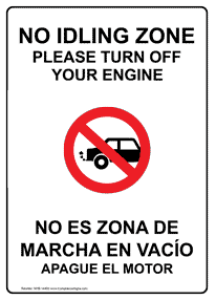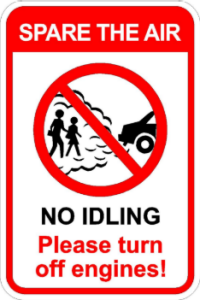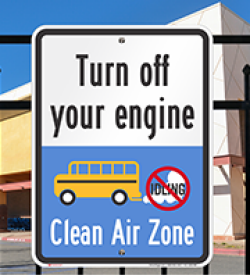Healthy Schools - No Idling Policy
Why is a "No Idling Policy" a healthier option?
Developing a “No Idling Policy” will improve the air quality at the school entrance and the surrounding area. Students miss approximately 10.5 million days of school each year due to asthma and there is a strong link between asthma, air quality and student exposure to exhaust from automobiles. In addition, exposure to exhaust inside of buses and automobiles is a serious health risk, even greater than walking or bicycling near those vehicles. A No Idling Policy is a simple, concrete measure to protect students on or near school grounds.
Policy development can be as simple as using the sample policy provided in the resources below to create your policy. Depending on resources, it can be done as a school student project or created and enforced by the school establishment. New policies are most effective when they have a strong champion to raise awareness of their benefits to all stakeholders.
What are reasons to support a No Idling Policy?
- Improve air quality by reducing hazardous pollution in your town or community. An idling vehicle spews out the same pollutants as a vehicle in motion. These pollutants have been linked to increased potential for asthma, heart disease, chronic bronchitis and cancer.
- Be environmentally conscious. Ten minutes of not running a car engine will prevent one pound of carbon dioxide, the primary contributor to global warming, from being released. By not idling, you can protect ecosystems and change the future.
- Save money. A car engine that is idling uses between 0.20 to 0.70 gallons of fuel an hour. An idling diesel engine burns approximately one gallon of fuel an hour. According to the Environmental Defense Fund, not idling your vehicle saves money.
- Protect your vehicle. Idling is an ineffective way to warm up your engine, as your vehicle is made up of many moving parts. A better way to warm your vehicle's transmission, tires, suspension, steering, and wheel bearings is to simply drive off slowly. Your car tends to warm up faster this way.


What are some more resources?
The EPA's Idle-Free Schools Toolkit includes information needed to run an effective idling reduction campaign at a school to reduce student exposure to toxic vehicle exhaust. EPA's Toolkit provides resources to make a student-run science or community involvement project, providing students with the opportunity to learn how to run a public service campaign while expanding their science and math skills.
ChangeLab Solutions' Safe Routes to School Policy Workbook was designed to help school board members, administrators, families of students and community members create and implement policies that support active transportation and Safe Routes to School programs. One of their recommended policies is the No-Idling Policy. Find out more about how to implement their policy here!
The School Superintendents Association created a sample No-Idling Policy that anyone can use.
